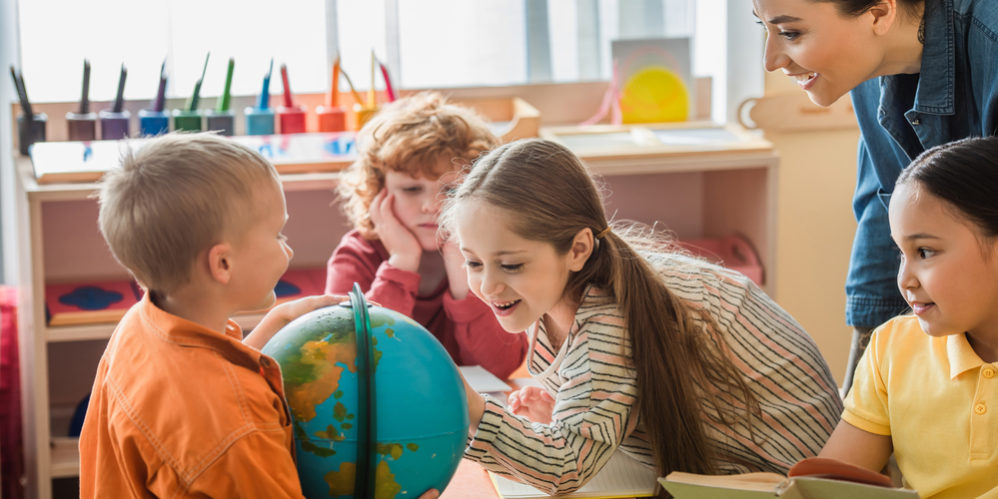Bright, colorful, and organized. That might be how someone describes a Montessori classroom when you ask them about it. On first glance, you might notice that the Montessori environment is organized to give the children as much space and freedom as possible. There is no teacher’s desk at the front of the classroom, only a prepared environment meant to serve the growth of every child in the room.
The Montessori prepared environment is integral to any Montessori school, but how does it work? Let’s find out.
What is the Prepared Environment?
Dr. Maria Montessori described the prepared environment as “a place where a child could be nourished for its design meets his needs for self-construction and helps him to reveal his personality and growth patterns.”
As stated in The Secret of Childhood by Montessori, “the first aim of the prepared environment is, as far as it is possible, to render the growing child independent of the adult.”
So what can we gather from these two descriptions? First, it’s important to understand that the prepared environment has to meet certain expectations in order to fulfill its purpose. Secondly, when done correctly, the prepared environment supports a child’s development and helps them gain life skills.
View this post on Instagram
The Key Components of the Prepared Environment
How does one make a prepared environment? By considering the six key components: structure and order, freedom, beauty, nature and reality, intellectual environment, and social environment. When a teacher begins to create the prepared environment, they take each of the components into consideration.
1. Organization and Structure
You will notice that every Montessori classroom has structure. Yet, that structure doesn’t stifle exploration and discovery. Rather, it supports it. The organization of the prepared environment helps with a child’s need for repetition and minimizes disorder.
2. Freedom of Choice
The Montessori philosophy discusses the benefits of allowing a child to follow their natural inclinations. Freedom of movement and choice (within limits) is essential to the prepared environment. This means that the child has enough flexibility and independence within the space to choose what they would like to do and how to go about it. The mentor or teacher is there to assist if help is needed.
3. Real and Natural
You won’t find many synthetic materials in a Montessori prepared environment. Dr. Maria Montessori had a deep love of nature, and she believed that children should also be exposed to natural things as much as possible. Many of the items that make up the classroom are made of metal, glass, cotton, bamboo, wool, and silk.
Additionally, these materials are child-sized and accessible. Tables, chairs, cups, cleaning tools, eating utensils, gardening shovels, and much more are made to fit the child, so they can learn how to use these items correctly and with less frustration.
4. Beauty
Montessori classrooms are colorful, warm and welcoming. There is no clutter, organization is maintained, and the overall atmosphere is peaceful. Children should be enticed to explore their environment.
5. Intellectual Environment
While the Montessori prepared environment is designed to help children develop physically, emotionally, and mentally, the classroom allows for each individual to grow in their own unique way. The space is filled with development-appropriate materials that can challenge a child as they grow. Plus, the materials provided cover a broad range of subjects, including Sensorial, Language, Cultural, Science, and Practical Life. Each item gives the child a means to build on their skills.
6. Social Environment
The classroom should also be a place where children can interact with their peers and develop empathy. Montessori classrooms are multi-age, meaning that 3-5 year old children, for example, can learn from one another. These groups encourage cooperation as well.
The Environment is the Teacher
When the environment of the classroom or a home is prepared sufficiently, children can discover their independence. When they can learn on their own, children are able to gain a sense of self-sufficiency and self-worth that is difficult to teach with more traditional methods.
This is a tremendous benefit to the developing mind. It is also a reason why the materials in the classroom are autodidactic. In other words, Montessori materials are designed to be used without needing previous instruction. Children use what they already understand to extrapolate the purpose of the material, so they can work without needing an adult. The child also understands when an error is made and can immediately begin figuring out how to correct the issue.
In many ways, the prepared environment is the teacher, while the instructors in the room are merely observers. Should children struggle, it is the environment that is altered to meet the children’s needs.
Looking for a Montessori School?
What makes the Montessori prepared environment so effective? Freedom within limits that allows for independence of thought, social interactions, and full use of the senses. Order is maintained and adult assistance is minimal. Without a prepared environment, the Montessori education would not be as effective as it is.
Fishtown Montessori has taken great care in creating a prepared environment that supports every child in the program. If you’re interested in a Montessori program for your child, we invite you to give us a call. We will schedule a virtual tour so you can see a class in action.






